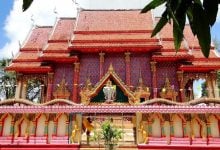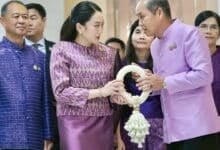Rocking history: Ancient artefact unearths Srivijaya secrets

Archaeologists revealed that an ancient sandstone artefact discovered in some temple grounds dates back to the era of the Srivijaya Kingdom.
A history tour group stumbled upon the sandstone while visiting Wat Palilaik in tambon Lamet. The group quickly informed Chaiya District Chief Chaowalit Rodjanarat about their find, suspecting the artefact to be over 1,000 years old due to its intricate carvings.
Chaowalit subsequently called upon Chaiya National Museum chairman Kitti Chinjoreontham and Phra Achan Mahathongchai, the abbot of Wat Rattanaram, to inspect the sandstone.
Kitti confirmed that the sandstone is indeed ancient and likely dates back to the 13th-14th centuries BE, aligning with the end of the Srivijaya Kingdom period.
“The artefact might be the base of a statue of the Hindu god Narayana, previously discovered in the area.”
The carvings on the sandstone bear a striking resemblance to those found at ancient Khmer castles. Currently, the artefact is housed at Wat Rattanaram, awaiting further examination by Fine Arts Department experts to determine its historical significance and origins, reported Bangkok Post.
In related news, a remarkable discovery of ancient skeletons, believed to be around 2,000 years old, caused quite a stir in Nakhon Ratchasima. Archaeologists uncovered two human skeletons during excavation work, with one skeleton’s skull placed on its torso, creating a buzz among locals and experts.
The discovery took place at 10am yesterday, May 29, during a project to landscape the Boraparam Moat area on Atsadang Road intersecting with Phon Lan Road in Nakhon Ratchasima Municipality. The project aims to transform the old city wall area into an educational historical site.
Those present included Prasert Boonchaisuk, the mayor of Nakhon Ratchasima, and Thananchai Wannasook from the Office of Environmental and Pollution Control Region 11, who inspected the site.
The excavation team, led by Thosaphon Srisaman, director of the 10th Fine Arts Office in Nakhon Ratchasima, along with archaeologists Kittipong Sonlek and Wannapong Palakawong Na Ayutthaya, discovered the skeletal remains buried 180 centimetres deep.
Latest Thailand News
Follow The Thaiger on Google News:


























